What causes a fear of cats? (Ailurophobia)

What causes a fear of cats, or Ailuro-phobia?
Some people are not cat people, or may dislike cats.
If you’ve ever been scratched or bitten by a cat, you may be quite wary of them.
In either of these cases, you’re not going to go out of your way to spend time with them, but you’re also not going to spend a lot of time worrying about them.
Phobias are a lot stronger than dislike.
And today we are talking about Ailurophobia, Felinophobia, Elurophobia,
Gatophobia, Galeophobia or just straight, Cat Phobia.
Ailuro originates from the Greek word for cat.
Feline from Latin
And Gato from Spanish.
Lots of ways to say, “cats really freak me out!”
With ailurophobia you might spend a lot of time worrying about encountering cats and thinking about ways to avoid them.
This can be pretty disruptive to daily life, especially as cats are a very popular pet.
Speaking of, this fear is usually about domesticated cats rather than large predatory cats.

You may experience anxiety or even panic when you see a cat, a cat makes physical contact with you, you see a picture of a cat, or even think about or imagine encountering a cat.
You may also experience anxiety when hearing sounds associated with cats,
like meowing, hissing, yowling, or purring.
Maybe this gets in the way of doing some things, like visiting certain friends
or family members with cats, or going where cats may be present.
Maybe it causes you to move to a building that doesn’t allow pets,
or you avoid co-workers who won’t stop talking about their furry friend.
Animal phobias in general are very common, but a specific fear of cats is very rare.
So rare that researchers can’t even tell us what portion of the population has this particular fear.
So what causes the fear of cats?
Often people do not know exactly what caused this phobia.
Though it generally traces back to early childhood.
This is commonly the case with phobias, especially animal ones.
It’s possible that it is a Learned fear – with a parent who is afraid of cats modelling this fear.
Or a parent told you to stay away from a sick or diseased looking cat, or cats in general.
Some people end up associating cats with disease or parasites, like toxoplasmosis, and cats are then associated with a contamination fear - a fear of disease or germs.
It’s common for people with a fear of cats to hold irrational beliefs about them, for example viewing them as “predatory or evil creatures.”
Evolutionary psychologists theorise that, like with sharks, we are preconditioned to fear cats,
as their much larger ancestors were a fearsome threat who preyed upon us.
The other way that people can end up with a fear of cats is from an early negative event.
As a child, you might invade a cat’s personal space and be scratched or bitten.
Or you may have observed someone else who was attacked by a cat.
Then the fear was generalised to all cats.
People are often under 3 years of age for these kinds of events and it’s common for neither child nor parent to recall it.
My wife Becky had negative events growing up with a rather unsociable white cat called Fizzy.
Fizzy would bite for no reason, get her claws out and climb her mum’s legs when she wanted food, and hide outside in the bushes, only to jump out at her or her brothers.
Presumably because of this, Becky’s much more wary of cats than I am.
I grew up with some lovely experiences of cats.
Becky’s got some fear around cats, but didn’t end up with a phobia.
Perhaps because she was already 2-3 years old or so by the time she had any of these negative cat experiences and there was no cat fear modelling by her parents or close relatives.

The fear of cats can range from mild to being severely affected – a full-blown phobia.
And often people manage their fear with avoidance.
You may have been semi-successfully avoiding cats in your life and are watching this video now because a friend, family member or neighbour got a cat, so now it’s more of an issue, as there’s a cat around to trigger you more often.
Generally, people are aware that their fears are irrational.
That they’re feeling intense fear, but that cats are unlikely to cause them serious harm.
Though unfortunately, this awareness often causes additional stress and feelings of shame, from holding beliefs that you know are a bit illogical.
This can make it more difficult to reach out for help.
Which is a massive shame as this is a fairly straightforward fear to treat, as with most phobias.
Treatment
First, you need a process to reduce your anxiety.
This can be done with a therapist, or online.
For example, our amazing online treatment, Anti-Anxiety Academy – where you can learn all the techniques, skills and strategies to reduce your anxiety
and get it down to a manageable level.
Now, the second and final stage you need to do what’s called exposure treatment.
This is where you get progressive exposure to, in this case, cat things.
You might even just start with words that remind you of cats, then images, sounds that cats make, videos of cats, then seeing a cat from afar and not moving away, moving progressively closer, then spending time with a known-to-be-friendly cat that belongs to a friend or family member...
and so on.
Why do you need this?
Well, while your prefrontal cortex can use the amazing anxiety reducing techniques from stage one, your midbrain only learns from experience.
It’s still freaking out back there!
Its adrenal signal is just being blocked by the prefrontal cortex and your new techniques.
To not have it react whenever you see a cat, you’ll need it to have experiences of being near or with cats and being safe.
Provide your midbrain with that and (provided there are no safety behaviours) you’ll get the much desired freedom from your phobia of cats.
Now, if you’re keen to get started on that exposure
The starting stuff can be done right from the device you’re reading from.
Just play this video that covers virtual exposure treatment for cat phobia to get underway.


